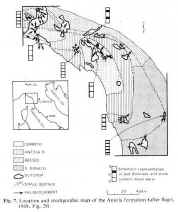|
Sedimentology, Vol. 25
(1978), 605-623
LITHOLOGIC TRANSITION AND
BED THICKNESS PERIODICITIES IN TURBIDITE SUCCESSIONS OF THE ANTOLA FORMATION,
NORTHERN APENNINES, ITALY
I. PETER MARTINI1,
MARIO SAGRI2 and JOHN H. DOVETON3
1 Department
of Land Resource Science, University of Guelph, Guelph, Ontario N1G 2W1, Canada
2Centro di Studio per la Geologia
dell'Appennino del CNR, Istituto di Geologia, Universita di Firenze, 50121
Florence, Italy 3Kansas Geological Survey, University of Kansas,
Lawrence, Kansas 66044, U.S.A
¡¡
 The Antola Formation of
Upper Cretaceous age crops out extensively in the Northern Apennines and
consists of graded units of calcareous sandstones, sand- stones, marlstones, and
shales. It can be subdivided into the Cerreto, Antola Marlstone, Bruggi, and S.
Donato Members on the basis of bed thickness and percentage of shales. Although
the whole formation is interpreted as a deep-sea basin plain deposit, the
members constitute lateral facies subdivisions that range from proximal,
thick-bedded turbidities that show a prevalence of thinning upward cycles in bed
thickness to distal turbidites that show predominantly thickening upward cycles
and have a high percentage of shale. The Antola Formation of
Upper Cretaceous age crops out extensively in the Northern Apennines and
consists of graded units of calcareous sandstones, sand- stones, marlstones, and
shales. It can be subdivided into the Cerreto, Antola Marlstone, Bruggi, and S.
Donato Members on the basis of bed thickness and percentage of shales. Although
the whole formation is interpreted as a deep-sea basin plain deposit, the
members constitute lateral facies subdivisions that range from proximal,
thick-bedded turbidities that show a prevalence of thinning upward cycles in bed
thickness to distal turbidites that show predominantly thickening upward cycles
and have a high percentage of shale.
Repetitive patterns in
the lithological sequence of the turbidite association are generally distinctive
and are satisfactorily described as first order Markov chains. Only the Antola
Marlstone Member has an additional second order Markov property. Imaginary
eigenvalues of the transition probability matrices of all but the Bruggi Member
demonstrate a strong cyclic character in the lithologic ordering within the
formation. The behavior of the Antola Marlstone and of the Bruggi may reflect
the influence of a secondary ophiolitic intra-basinal source of clastics that
contributed sandy turbidites and olistostromes.
Systematic long-term
variations in the sequence of bed thickness development in some sections of the
Antola Formation are often subtle and equivocal, and pose special problems in
interpretation. Fourier analysis was applied to the task of partitioning
fundamental wavelengths from 'background noise' introduced by essentially random
depositional processes. In all members there is (1) strong short-term wavelength
of two to three beds indicative of alternating thin and thick beds and judged to
be typical of turbidite sequences; (2) an intermediate wavelength ranging from
about five beds (proximal facies), eight beds (distal) to nine beds (very
distal), which have both thinning and thickening upward trends, interpreted
respectively as valley fill due to shifting thalweg of low density turbidity
currents, and to progradational, flat turbidite lobes; (3) a poorly defined
long-term wave- length of from thirty to greater than sixty beds that may be
related to an unspecified trend in the evolution of the sedimentary basin. Phase
angles associated with the computed power spectra give indications as to the
asymmetry (thickening or thinning upward) or symmetry of the representative
units.
|